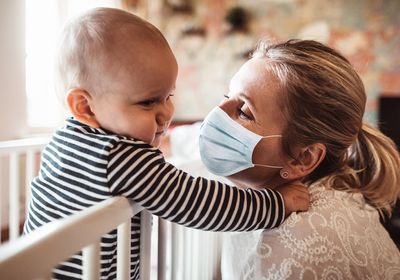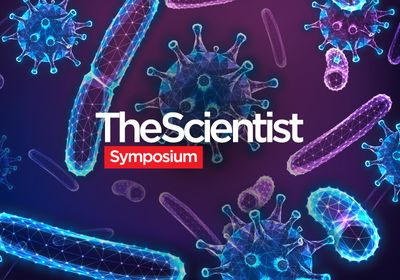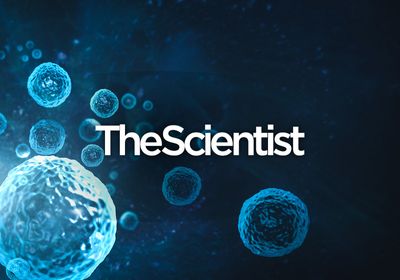ABOVE: Infant gut microbial diversity plummeted when lockdown restrictions abruptly came into effect. ©iStock, franckreporter
Bacteria rapidly colonize the gut of a newborn immediately following birth, creating the microbiome.1 Social and environmental factors influence the makeup of the microbiome after birth. In fact, babies born by Caesarian section initially develop microbiomes that are distinct from their parent’s when compared to infants delivered naturally who pick up bacteria as they pass through the vaginal canal.2 The early days of the COVID-19 pandemic required social distancing measures and heightened hygiene practices, but it wasn’t clear how this might affect the infant microbiome. Now, communicated in Scientific Reports, researchers report that infant microbiome diversity plummeted when the pandemic spiked.3
Sarah Vogel, a developmental psychologist at Boston University, was working at New York University when SARS-CoV-2 began to spread across the globe. At the time, Vogel and her colleagues were carrying out a large study exploring how factors like socioeconomic status and caregiver wellbeing affect early development in infants. When lockdown restrictions came into effect, the laboratory closed, and the project came to an abrupt halt, except for one small project on the microbiome. The researchers initially planned to explore how the microbiome influences neurocognitive development. However, they anticipated that the lockdown would alter infants’ exposure to bacteria, so they quickly pivoted to studying whether the pandemic slashed gut microbiome diversity.
Unable to go into the laboratory, the team needed to adapt their working protocol. “You can picture me at home throughout 2020 on the phone with parents—texting them, calling them, emailing them—trying to get them to participate in this part of the study,” Vogel said. Gut bacteria are normally sampled from stool, so Vogel and her team mailed stool collection kits to participating families. They then sent the unsightly packages off for sequencing to determine the microbiome’s makeup from the bacterial RNA in the samples.
See also “When Microbes Meet the Immune System”
The team hypothesized that social distancing measures, such as daycare closures, fewer outdoor activities, and limited social interactions might limit the bacteria infants contact and reduce their microbial milieu. Indeed, Vogel found that infant microbiome diversity declined as soon as the pandemic began. This was true for the number of bacterial species within an individual, but also for bacterial diversity between infants, whose microbiomes became similar after the pandemic. “This is a fairly moderately sized effect,” Vogel noted. “But to what extent these differences translate to observable differences in health remains a little bit unclear.”
Researchers have previously tried to study how microbiome diversity affects child health, but their work yielded mixed results. Some researchers demonstrated that a drop in gut diversity predisposed children to a slew of unwanted immune reactions like asthma and food allergy, while others found that there isn’t enough evidence to make this connection.4–6 In this study, Vogel said, “None of the parents that I spoke to gave any indication that their child was experiencing any kind of health concerns out of the normal.”
Edoardo Pasolli, a bioinformatician at the University of Naples Federico II who was not involved in the study said, “The choice of the infant microbiome was a good one because we know that changes during the first weeks, months, and years of life can be affected by multiple factors, much more than the adult microbiome that is more stable.” Given the malleability of the infant microbiome, it’s possible that gut diversity returned to prepandemic levels once New York relaxed lockdown restrictions. However, the researchers were unable to run follow-up experiments on the infants. “There may be more of a delay on the maturation of the microbiome,” Pasolli speculated.
With only 54 infants under the age of one, Vogel lacked the statistical power to study changes in most individual bacterial lineages. However, she observed a decline for the Pasteurellaceae family, including the genus Haemophilus, a phenomenon linked to scrupulous cleaning practices in other studies.7
The team accounted for many variables that might affect microbiome diversity, like age and demographic background, Pasolli noted. They also controlled for breastfeeding, which Vogel said has one of the largest effects on microbiome diversity.8 However, it’s unclear whether these findings are generalizable since all of the participants lived in New York City, which Vogel said faced tougher restrictions than other places. “We were hit much harder and much earlier,” she explained. It’s possible that infant gut microbiomes elsewhere may not have changed as much.
See also “The Infant Gut Microbiome and Probiotics that Work”
If she were to repeat the study, Vogel said that she would aim to recruit a more geographically diverse cohort of participants to study the microbiome in different environments. She would also like to explore how infant microbiomes differ between households that are disproportionately affected by lockdowns, such as ones containing essential workers versus those who work entirely from home.
“We know that lifestyle has a big impact on the human microbiome,” Pasolli said. He suggested that future studies should track changes in infant microbiomes over time to see whether they recover their diversity in the wake of a pandemic.
References
- Gensollen T, et al. How colonization by microbiota in early life shapes the immune system. Science. 2016;352(6285):539-544.
- Zhou L, et al. Effects of vaginal microbiota transfer on the neurodevelopment and microbiome of cesarean-born infants: A blinded randomized controlled trial. Cell Host Microbe. 2023;31(7):1232-1247.
- Querdasi FR, et al. A comparison of the infant gut microbiome before versus after the start of the covid-19 pandemic. Sci Rep. 2023;13(1):13289.
- Patrick DM, et al. Decreasing antibiotic use, the gut microbiota, and asthma incidence in children: evidence from population-based and prospective cohort studies. Lancet Respir Med. 2020;8(11):1094-1105.
- Tanaka M, et al. Signatures in the gut microbiota of Japanese infants who developed food allergies in early childhood. FEMS Microbiol Ecol. 2017;93(8).
- Bunyavanich S, Berin MC. Food allergy and the microbiome: Current understandings and future directions. J Allergy Clin Immunol. 2019;144(6):1468-1477.
- Tun MH, et al. Postnatal exposure to household disinfectants, infant gut microbiota and subsequent risk of overweight in children. CMAJ. 2018;190(37):1097-1107.
- Pannaraj PS, et al. Association between breast milk bacterial communities and establishment and development of the infant gut microbiome. JAMA Pediatr. 2017;171(7):647-654.







